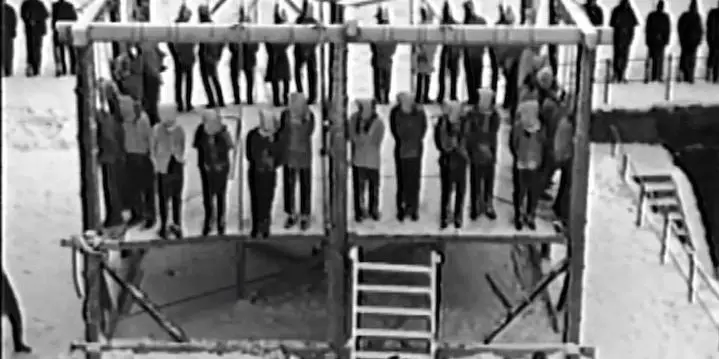Abraham Lincoln Ordered the Execution of 39 Men-Truth! & Fiction!
Summary of eRumor:
Abraham Lincoln ordered the mass execution of 39 men in 1862 for treaty violations like hunting on land outside of their reservation.
The Truth:
This eRumor is based on real events, but it gets most of the details wrong.
A Facebook post that appeared on social media includes a photo of dozens of men hanging from a gallow with a caption that begins:
“This picture is of 39 men that were ordered to be executed by Abraham Lincoln for treaty violations (hunting off of their assigned reservation). Yes the ‘Great Emancipator’ as the history books so fondly referred to him as.”
It’s true that 38 (not 39) Dakota men were executed on December 26, 1862, in America’s largest mass execution ever. But the eRumor’s first false claim is that the men were executed for things like “hunting off of their assigned reservation.”
The truth is that the Dakota men were hanged after a bloody conflict with white settlers. The Dakota were frustrated with late annuity payments for land, with corrupt traders and government officials, and with not having a way for their complaints to be heard, according to records kept by the University of Missouri-Kansas City.
Then, in August of 1862, it boiled over when four young Dakota men killed five white people, including a 14-year-old girl. The Dakota men got into an argument about stealing chicken eggs from a white farmer, and the killings were to prove to each other that they weren’t afraid of white men, Big Eagle, a member of the Dakota at the time, later recalled.
That led to a bloody conflict between the Dakota and the white settlers of Minnesota over the next couple months. There were as many as 600 white people killed and hundreds more Dakota. More than a thousand Dakota were taken prisoner and Colonel Henry Sibley — who had been appointed by Minnesota’s governor to handle the conflict — set up a military commission to try the prisoners for “murders and outrages” committed against Americans, according to historical accounts of the trials:
“The trials were elaborately conducted until the commission became acquainted with the details of the different outrages and battles, and then, the only point being the connection of the prisoner with them, five minutes would dispose of a case.
“If witnesses testified, or the prisoner admitted, that he was a participant, sufficient was established. As many as 40 were sometimes tried in a day. Those convicted of plundering were condemned to imprisonment; those engaged in individual massacres and in battles, to death.”
The commission had sentenced 307 Dakota to death by the end of the trials. A list of Dakota men who were to be executed was sent to Abraham Lincoln for approval. And, this is the second time that the eRumor jumps the rails. Lincoln’s action to pardon most of the men infuriated Minnesotans and has been viewed by many as an example of Lincoln’s “Solomon-like wisdom,” according to the Johns Hopkins University Press:
“Lincoln willfully ordered this mass hanging in order to appease a Minnesota settler populace threatening riots and anarchy, perhaps even secession, if he did not do as they demanded.
“During the war trials that followed the 1862 conflict, President Lincoln was made aware of the conditions on the Dakota reservations, particularly at Lower Sioux, in addition to Minnesotans’ clarion call for the Dakotas’ extermination. With this in mind, the process through which Lincoln decided to reduce the number of condemned from three hundred and three to thirty-nine (with the thirty-ninth acquitted at the last moment) is seen by some as another example of this president’s Solomon-like wisdom. In other words, Lincoln is credited with having drawn a difficult compromise between a vengeful populace and a defeated Indian nation reduced to being prisoners of war. Even Dakota writer and activist Charles Alexander Eastman, whose father and uncles fought against the United States in 1862, expressed his gratitude for Lincoln’s magnanimity, when he stated in his 1915 book ‘The Indian To-Day’ that a ‘new Indian policy’ emerged when Lincoln refused ‘to order the execution of three hundred Sioux braves, whom a military court had, in less than two days, convicted of murder and condemned to be hung, in order to satisfy the clamor of the citizens of Minnesota.’”
It’s true that actions taken by Congress forced the Dakota from Minnesota after the executions were carried out on December 26, 1862 — but it’s not fair to place all the blame for that on Lincoln, the Minnesota Indian Affairs Council reports:
“The original Dakota Community was established by treaty in 1851. The treaty set aside a 10-mile wide strip of land on both sides of the Minnesota River as the permanent home of the Dakota. However, in the aftermath of the U.S.-Dakota Conflict of 1862, Congress abrogated all treaties made with them and the Dakota were forced from their homes in the state. The four communities were reestablished in their current localities by acts of Congress in 1886. The four Dakota Communities today represent small segments of the original reservation that were restored to the Dakota by Acts of Congress or Proclamations of the Secretary of Interior.”
Lastly, the photo of men hanging from a gallows that appears with the eRumor is likely not a photo of the actual Dakota execution. The photo doesn’t exist in the Minnesota Historical Society’s archive, and the men in the photo are dressed like Europeans, not Dakota. It’s highly unlikely that Minnesotans would have given Dakota men new pants, vests and coats before their execution.
In the end, a lot of factors led to the Dakota conflict and the fallout that followed it. Arguments can be made that the Dakota were treated unfairly, but its wrong to pin all the blame for the mass execution on Lincoln, as this eRumor attempts to do.

